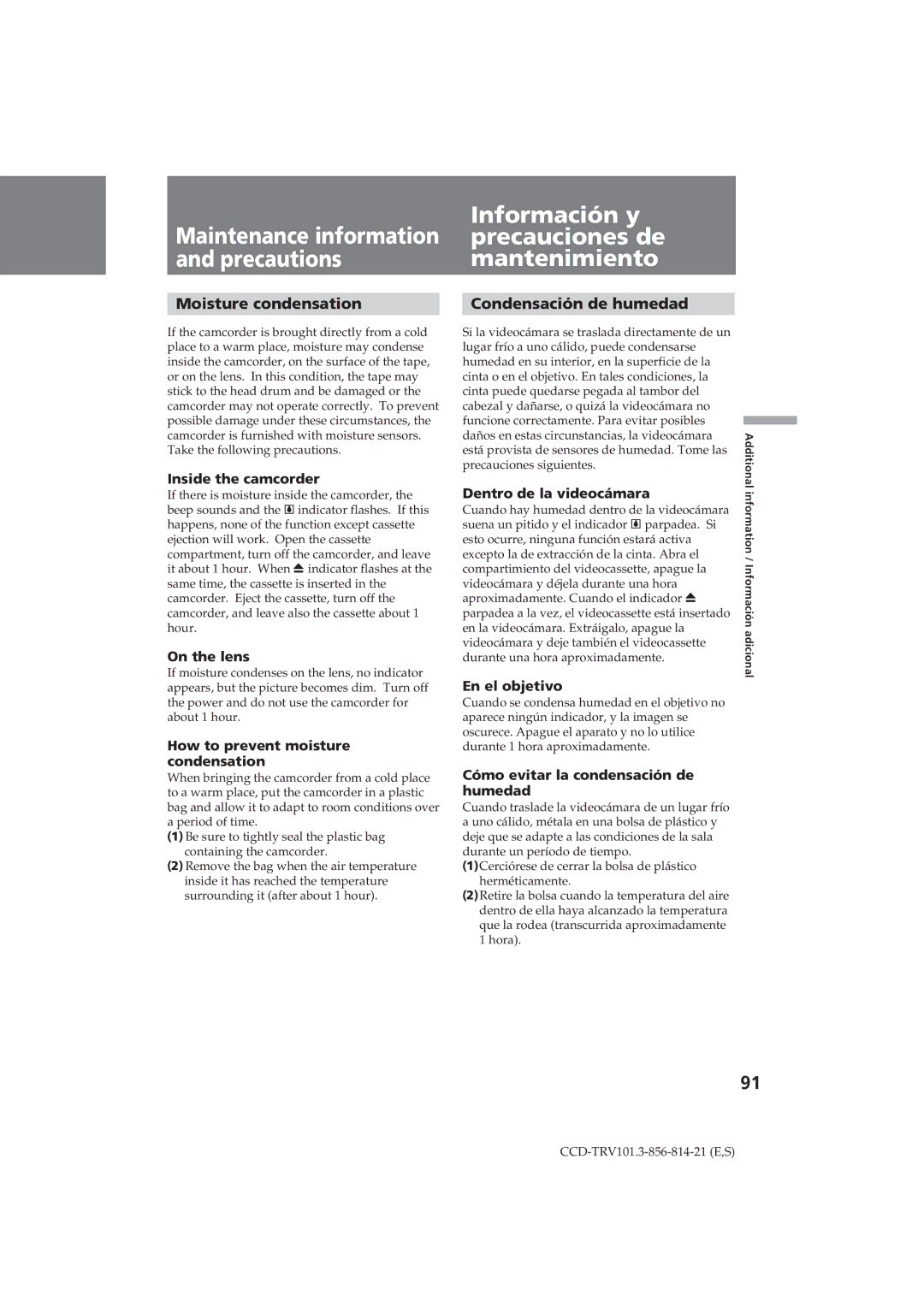
Maintenance information and precautions
Moisture condensation
If the camcorder is brought directly from a cold place to a warm place, moisture may condense inside the camcorder, on the surface of the tape, or on the lens. In this condition, the tape may stick to the head drum and be damaged or the camcorder may not operate correctly. To prevent possible damage under these circumstances, the camcorder is furnished with moisture sensors. Take the following precautions.
Inside the camcorder
If there is moisture inside the camcorder, the beep sounds and the {indicator flashes. If this happens, none of the function except cassette ejection will work. Open the cassette compartment, turn off the camcorder, and leave it about 1 hour. When 6 indicator flashes at the same time, the cassette is inserted in the camcorder. Eject the cassette, turn off the camcorder, and leave also the cassette about 1 hour.
On the lens
If moisture condenses on the lens, no indicator appears, but the picture becomes dim. Turn off the power and do not use the camcorder for about 1 hour.
How to prevent moisture condensation
When bringing the camcorder from a cold place to a warm place, put the camcorder in a plastic bag and allow it to adapt to room conditions over a period of time.
(1) Be sure to tightly seal the plastic bag containing the camcorder.
(2) Remove the bag when the air temperature inside it has reached the temperature surrounding it (after about 1 hour).
Información y precauciones de mantenimiento
Condensación de humedad
Si la videocámara se traslada directamente de un |
| |
lugar frío a uno cálido, puede condensarse |
| |
humedad en su interior, en la superficie de la |
| |
cinta o en el objetivo. En tales condiciones, la |
| |
cinta puede quedarse pegada al tambor del |
| |
cabezal y dañarse, o quizá la videocámara no |
| |
funcione correctamente. Para evitar posibles |
| |
daños en estas circunstancias, la videocámara | Additional | |
está provista de sensores de humedad. Tome las | ||
| ||
precauciones siguientes. |
|
Dentro de la videocámara | information/ | |
excepto la de extracción de la cinta. Abra el | ||
Cuando hay humedad dentro de la videocámara |
| |
suena un pitido y el indicador { parpadea. Si |
| |
esto ocurre, ninguna función estará activa |
| |
compartimiento del videocassette, apague la | Información | |
videocámara y déjela durante una hora | ||
| ||
aproximadamente. Cuando el indicador 6 |
| |
parpadea a la vez, el videocassette está insertado |
| |
en la videocámara. Extráigalo, apague la | adicional | |
videocámara y deje también el videocassette | ||
| ||
durante una hora aproximadamente. |
| |
En el objetivo |
| |
Cuando se condensa humedad en el objetivo no |
| |
aparece ningún indicador, y la imagen se |
| |
oscurece. Apague el aparato y no lo utilice |
| |
durante 1 hora aproximadamente. |
| |
Cómo evitar la condensación de |
| |
humedad |
| |
Cuando traslade la videocámara de un lugar frío |
| |
a uno cálido, métala en una bolsa de plástico y |
| |
deje que se adapte a las condiciones de la sala |
| |
durante un período de tiempo. |
| |
(1)Cerciórese de cerrar la bolsa de plástico |
| |
herméticamente. |
| |
(2)Retire la bolsa cuando la temperatura del aire |
| |
dentro de ella haya alcanzado la temperatura |
| |
que la rodea (transcurrida aproximadamente |
| |
1 hora). |
|
91
